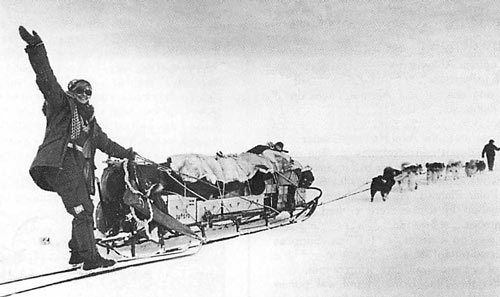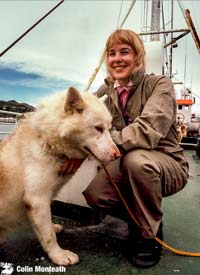Monica Kristensen's South Pole Expedition
|
Because of heavy ice conditions, Aurora reached the Bay of Whales on 6 December, about 3 weeks later than planned. The base camp was established at 78º21'S-165º07'W, with assistance from a chartered helicopter. Meanwhile, a chartered Twin Otter arrived from New Zealand; its main task was to establish five depots along the planned route to Pole. Depot 5, the southernmost of these, was at 88º30'S. The Twin Otter also flew some of the expedition members south so they could view their planned route from the air. The team set out for Pole on 17 December 1986. Their route took them south across the Ross Ice Shelf to the Axel Heiberg Glacier, partially following Amundsen's route. They reached Depot 4 on the Antarctic Plateau (85º57'S) on 25 January. But by this time there were serious concerns in Norway that the venture would not reach Pole before the station closed on 14 February. According to deputy NSF polar programs director Al Fowler, the expedition sent their support aircraft home when their contract for its services expired. They waited for more than a week at their southernmost camp, while attempting in vain to obtain air support from Giles Kershaw's then-fledgling organization which would soon become Adventure Networks. So after going a few miles south to 86º they turned around and headed back north on 29 January. They returned to their base camp on 27 February and were picked up by the Aurora on 1 March. I was at Pole when this expedition was happening. And there was serious concern, as many people there had been present during the previous summer when the "Footsteps of Scott" expedition had arrived, and they'd witnessed the sad aftermath. NSF DPP director Peter Wilkniss (as well as the New Zealand authorities) had told Norway that they must urge Monica to turn back. And there was a great collective sigh of relief on station when she decided to do so. Monica would reach Pole late in the 1991-92 season leading the Aurora Programme, a privately sponsored glaciology expedition. The team traveled to the ice on the MV Aurora (which Monica had previously purchased for her unsuccessful 1986-87 NGA South Pole trip) and set up a 5-hut base (Blåenga) at 77.5ºS-34.2ºW. While other scientific studies were underway elsewhere, the expedition Twin Otter was damaged and had to head north for repairs, so the planned Pole visit to search for the tent was delayed and shortened. Finally, Monica and fellow glaciologist Heinrich Eggenfellner were able to fly to Pole on 16 February 1992, although the planned aerial radar survey equipment could not be installed on the aircraft. They were only at Pole for a few hours. They received NSF support on station as they were focusing on glaciology, so they were provided a Spryte tracked vehicle. They set up a pyramid tent above the presumed location of Amundsen's tent, using data from Scott's and Amundsen's records, GPS, and reportedly, a brief GPR survey, which discovered a void which may have been the tent. Monica's main purpose here was to recover the tent for display at the 1994 Lillehammer Winter Olympics--an effort partially sponsored by the Lillehammer (Norway) Olympic Organizing Committee. My coverage of the Aurora Programme and the tent search is here. The photo at the top of this page originally appeared in Verdens Gang (VG), the Oslo newspaper which had exclusive news rights for the expedition. Another significant reference for the 1986-87 expedition is Walter Sullivan's 3 February 1987 New York Times article (which is behind a paywall unless you are a Times subscriber). Other information sources include various Antarctic articles (this is the journal of the New Zealand Antarctic Society which is now also behind a paywall). A detailed discussion of the Aurora expedition is out there on blog posts from participant David Mantripp....go here for all four long posts with photos! Monica would return to the ice one more time, in 1993-94. Members of her expedition (not including Monica) were traversing toward Pole in December 1993 as part of the tent recovery project, when they encountered a crevasse field in the Shackleton Range, and Norwegian Jostein Halgested is killed after falling into a 130-foot crevasse. The other three traverse members were rescued by a SAR team that flew to the incident site from McMurdo via Pole. The survivors were flown onward to McMurdo and Christchurch. Two other expedition members (perhaps including Monica) had previously been flown to Pole by ANI, and they were flown out to Punta Arenas by ANI. | ||

